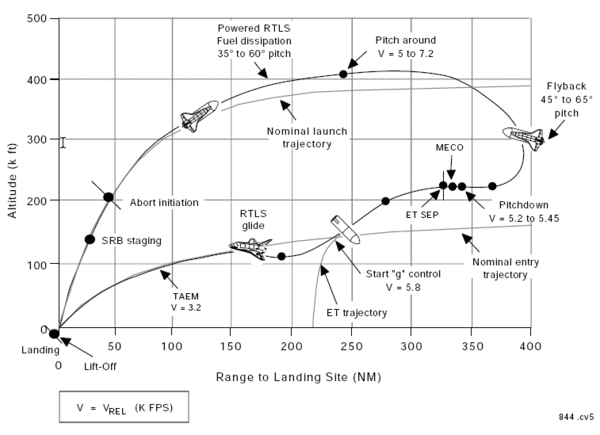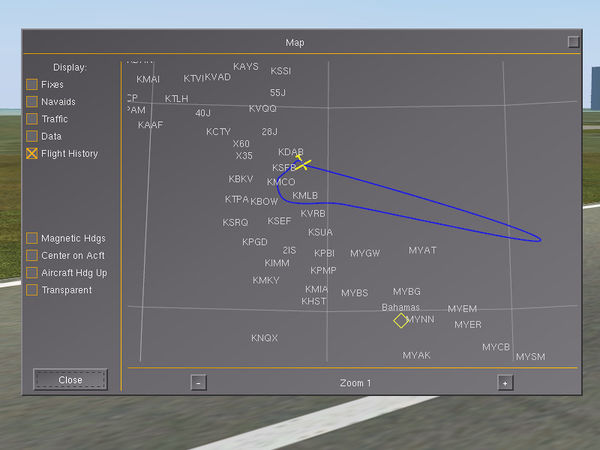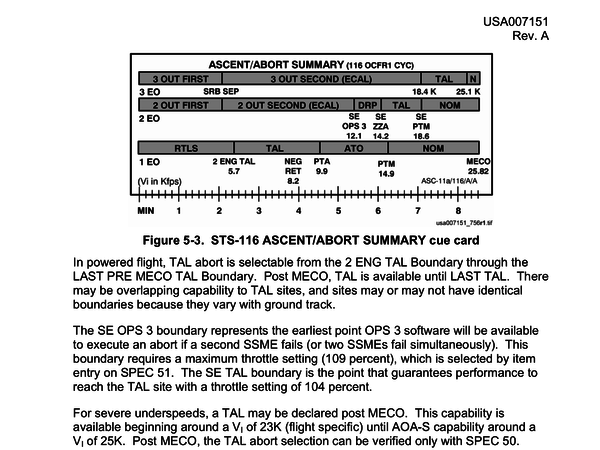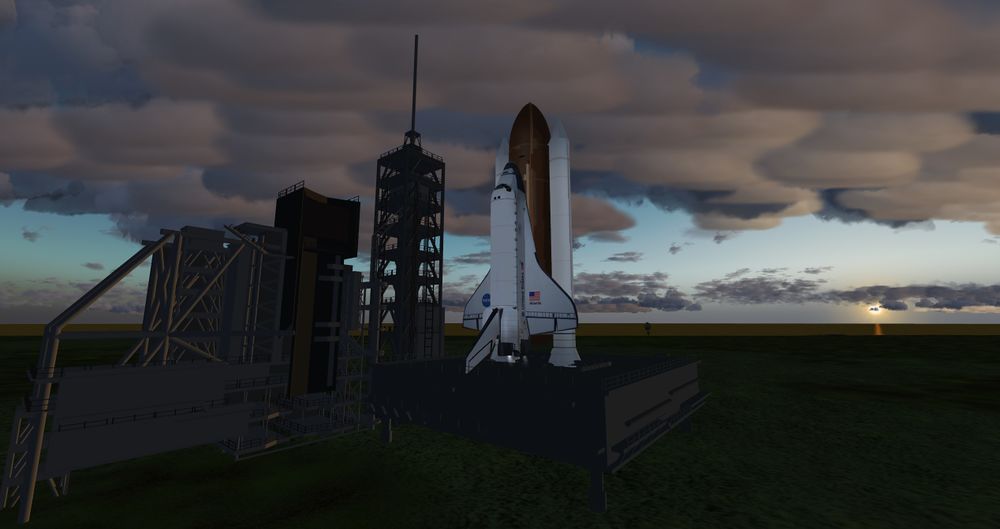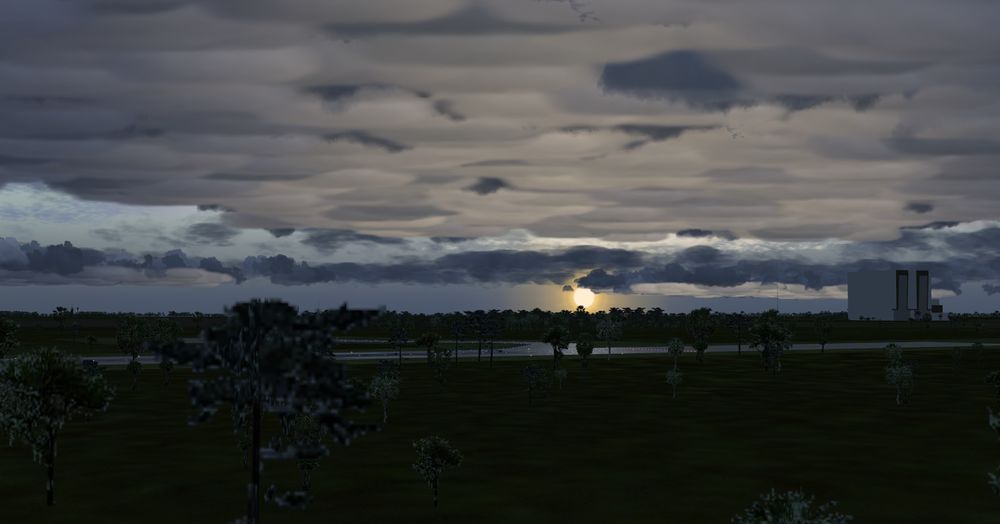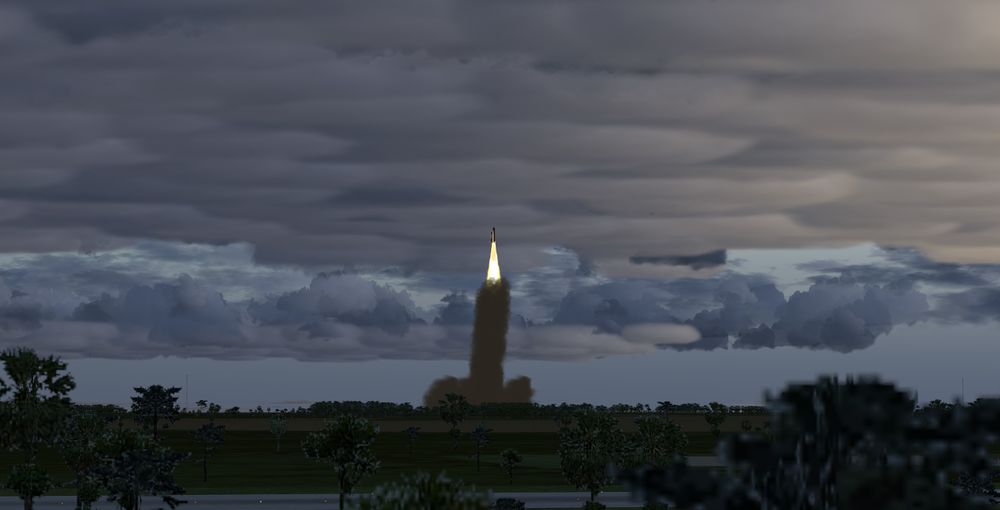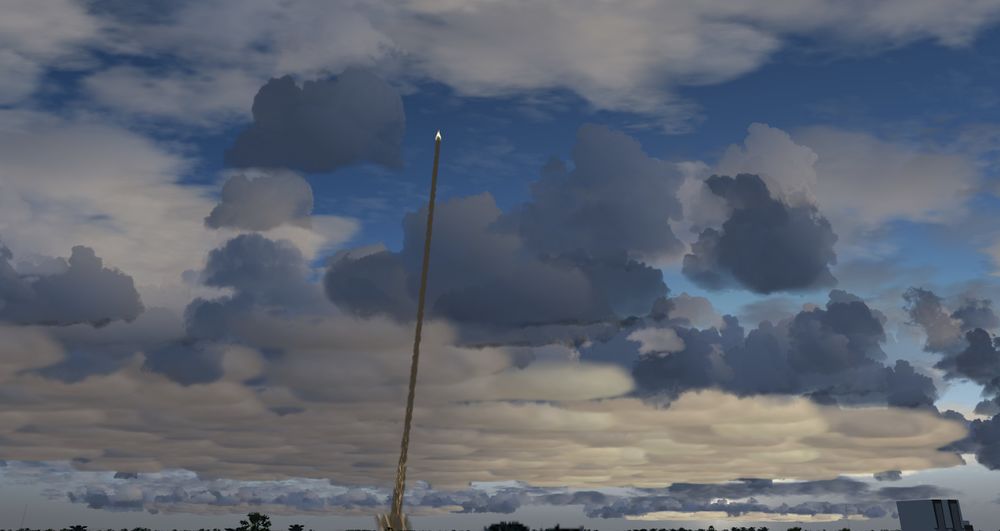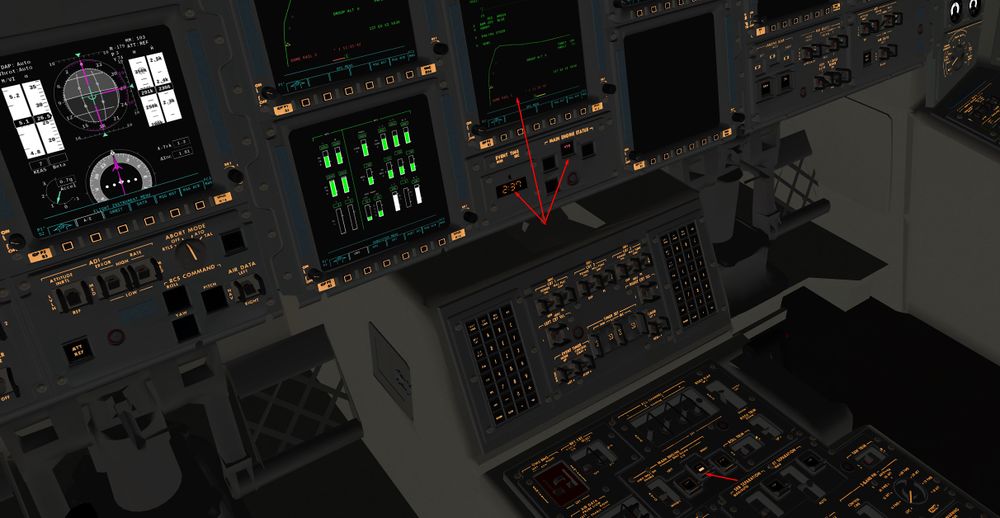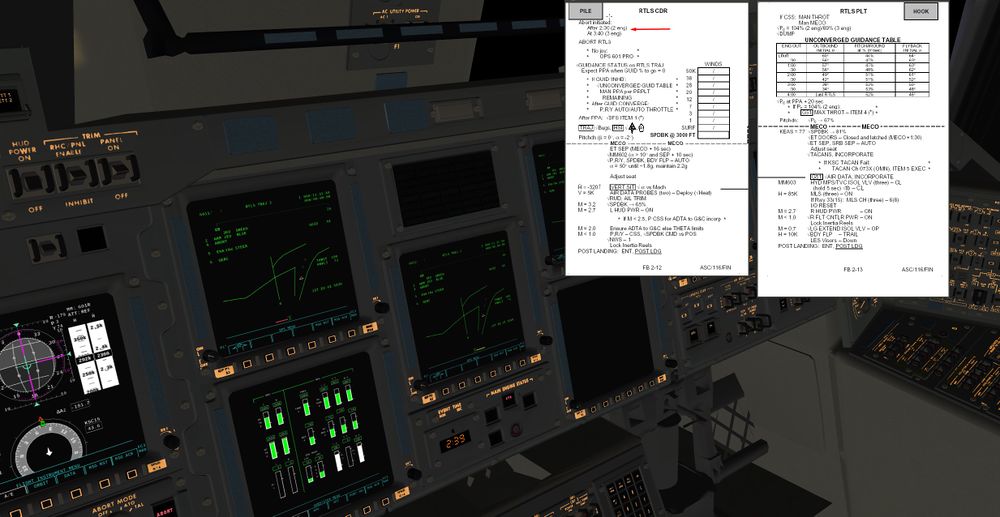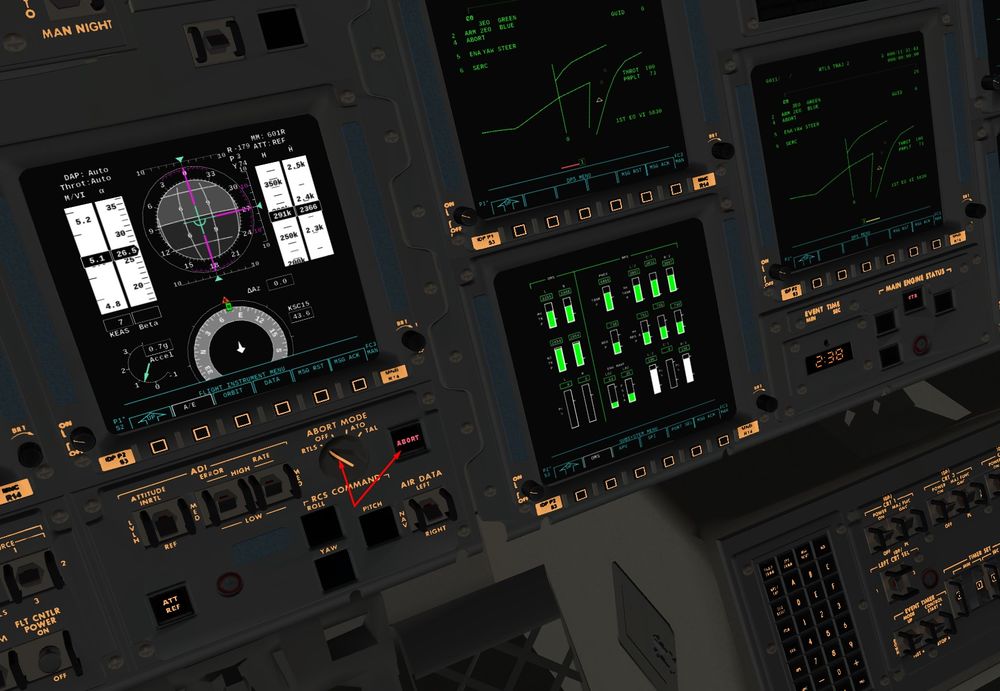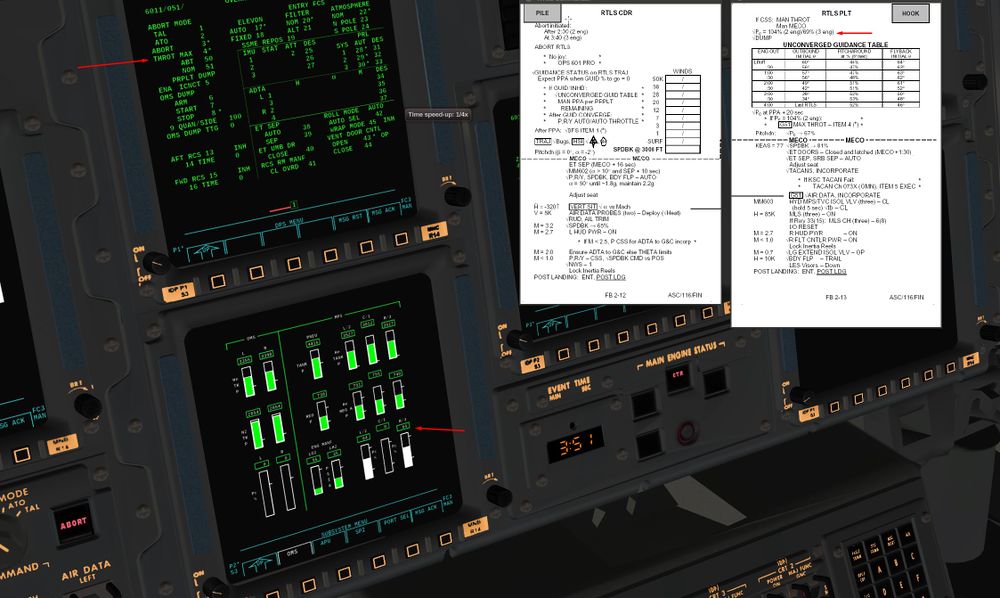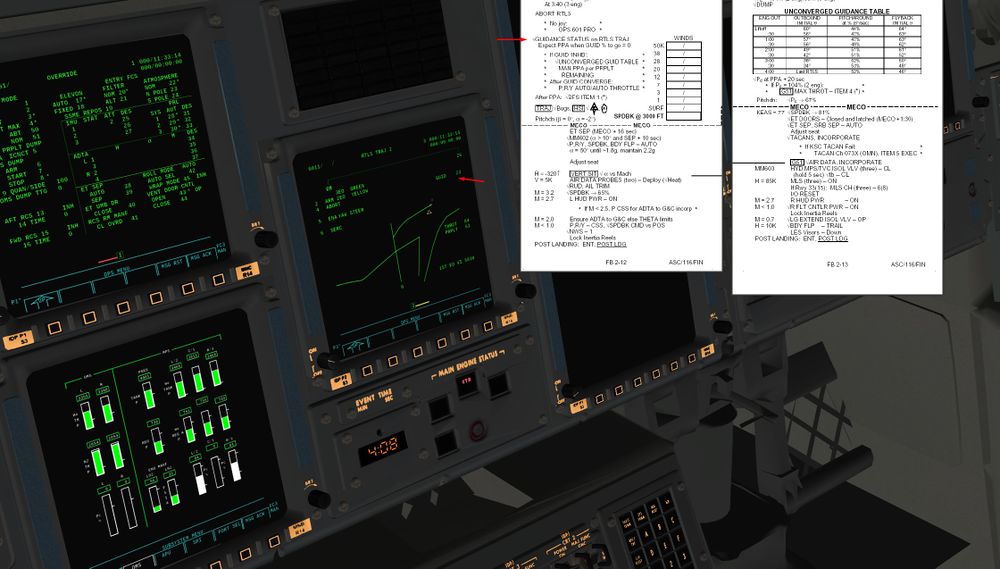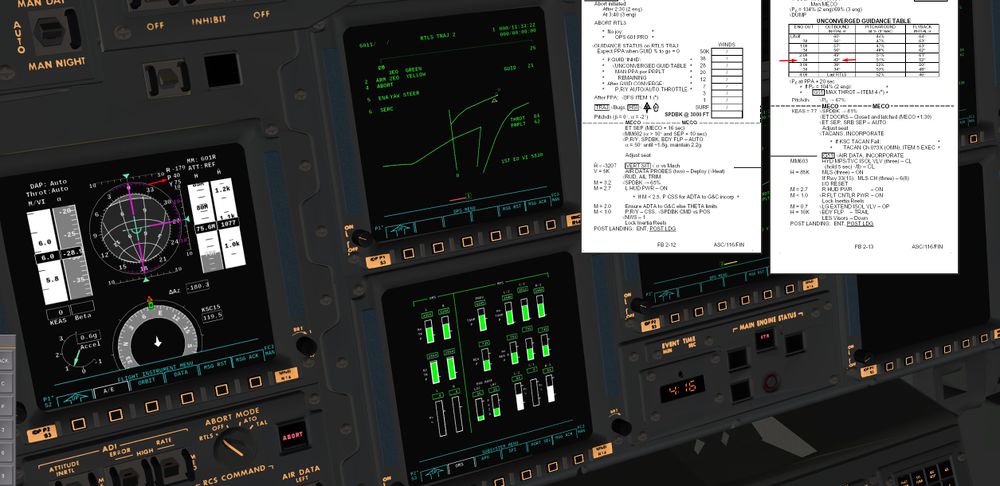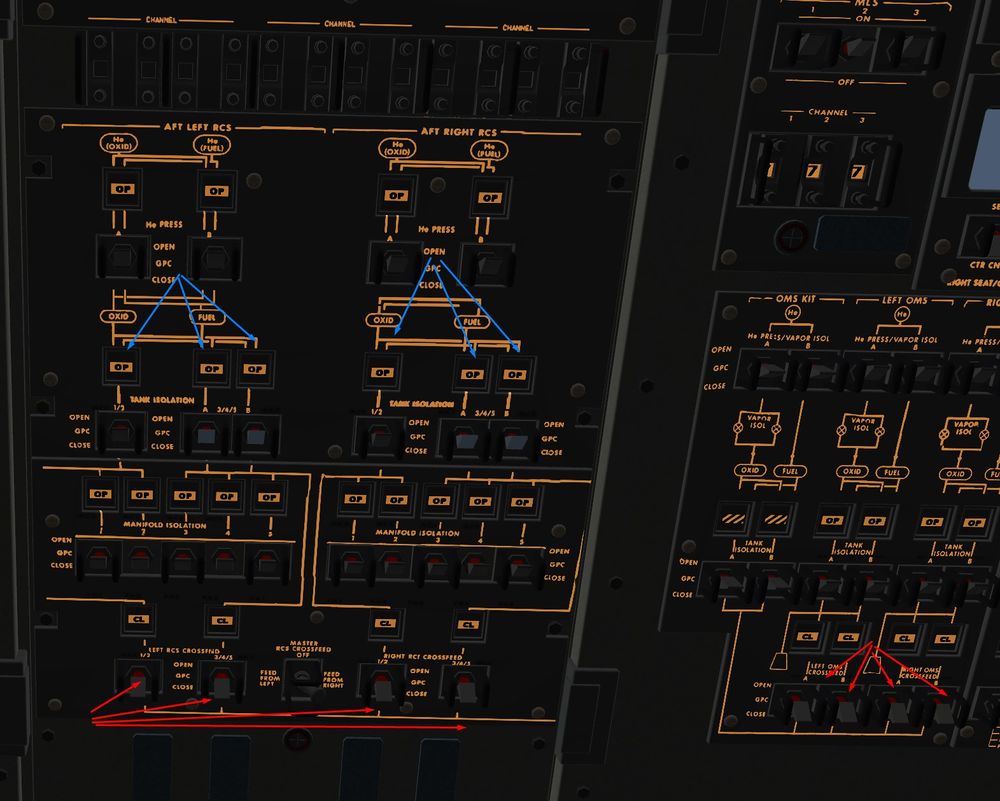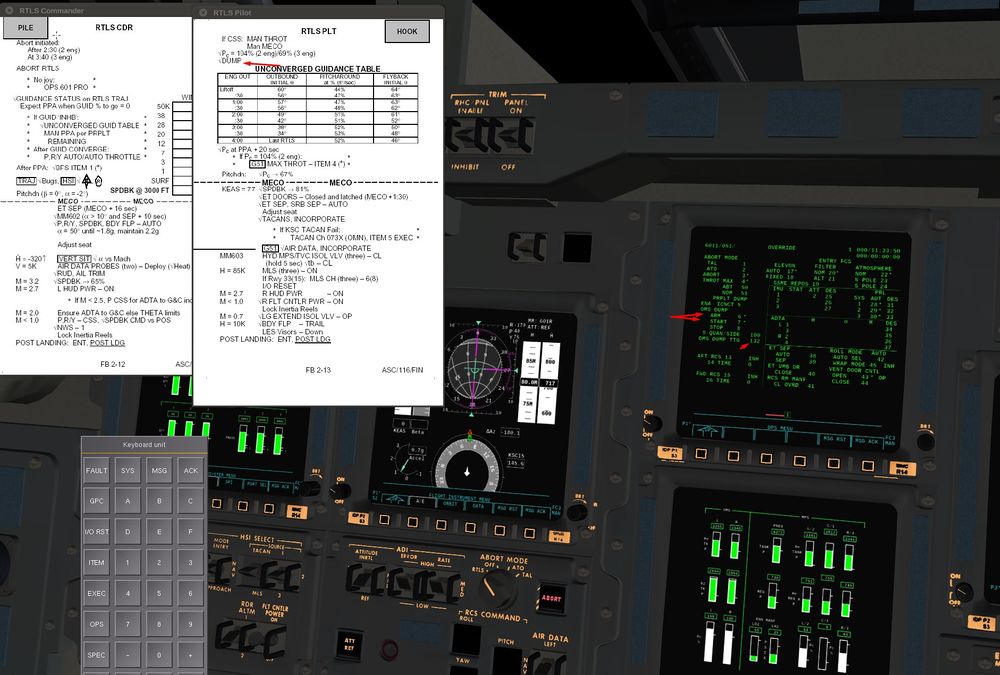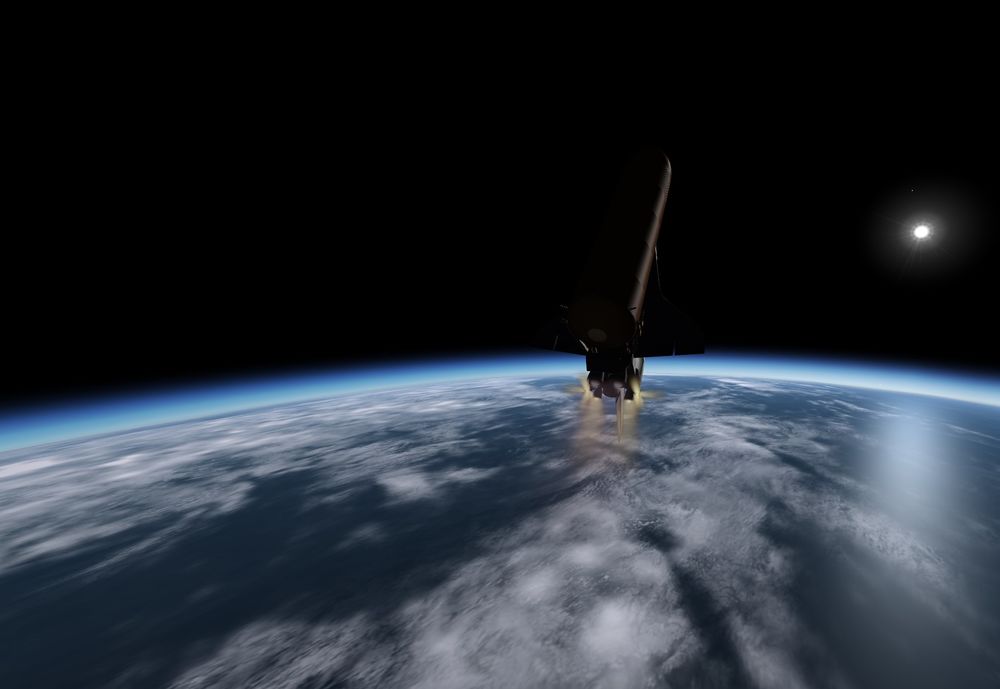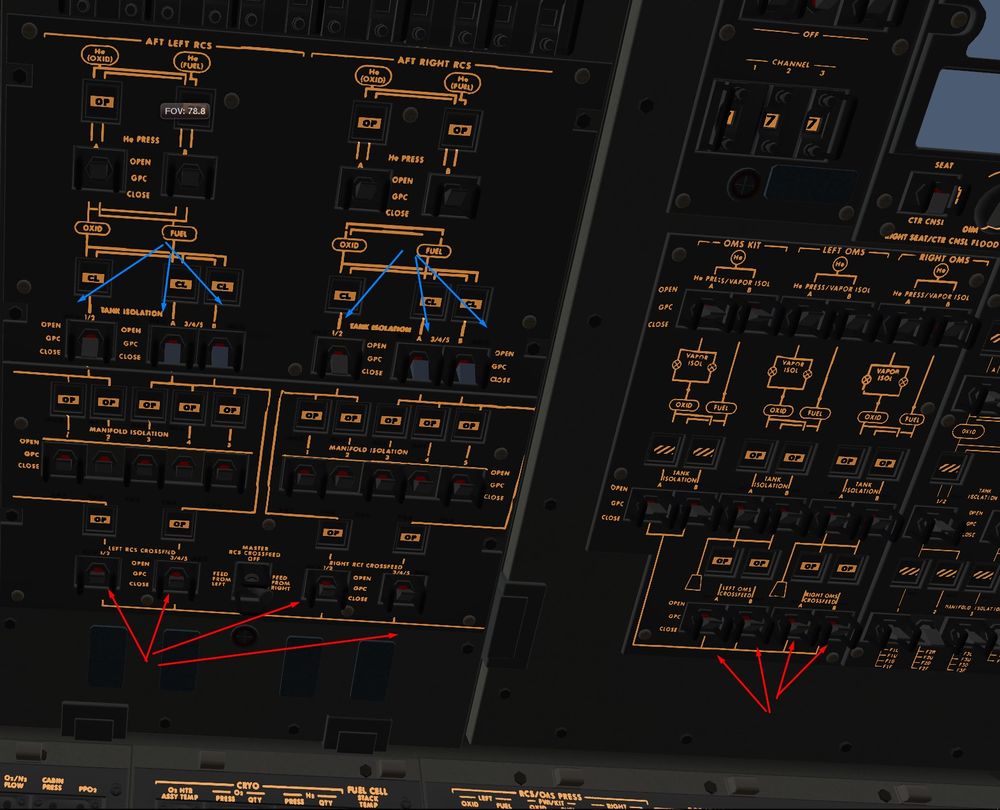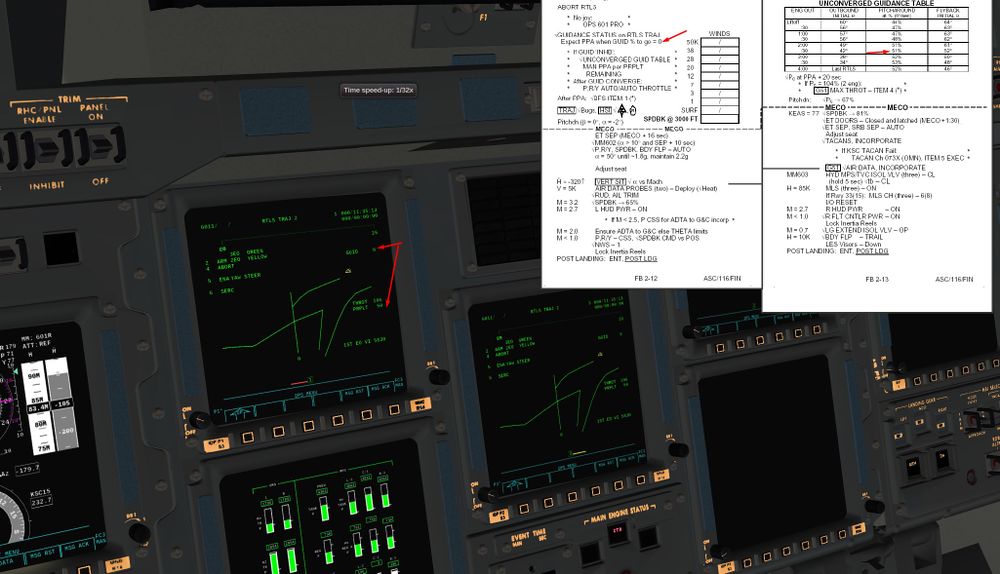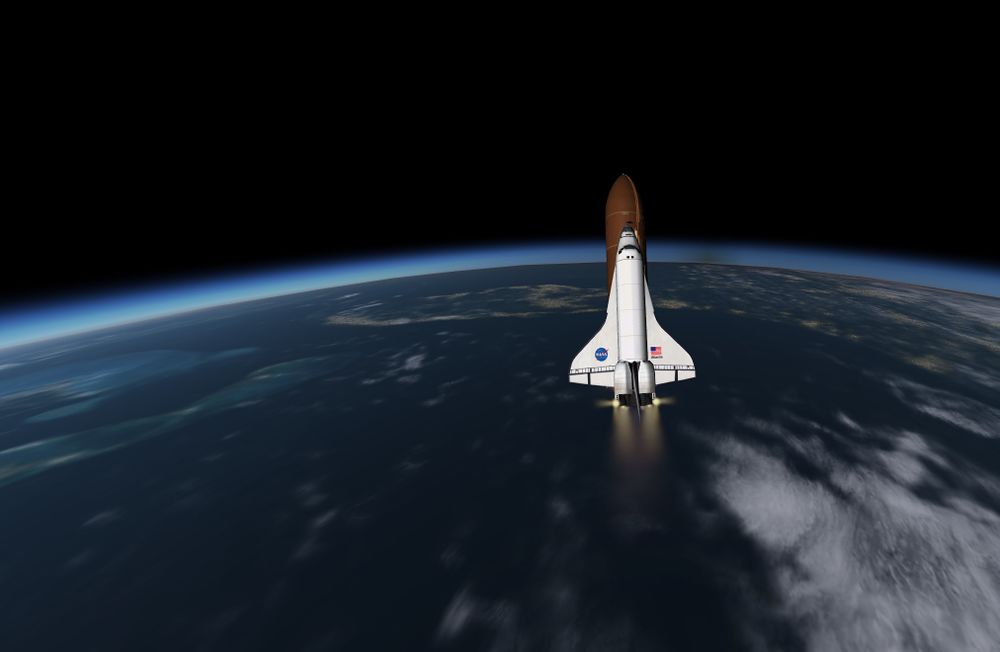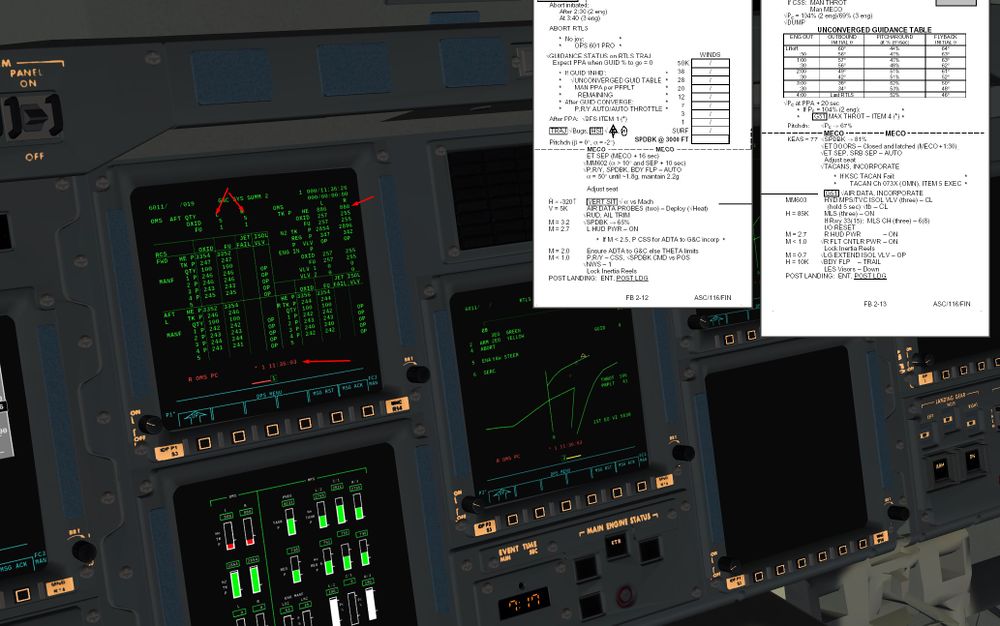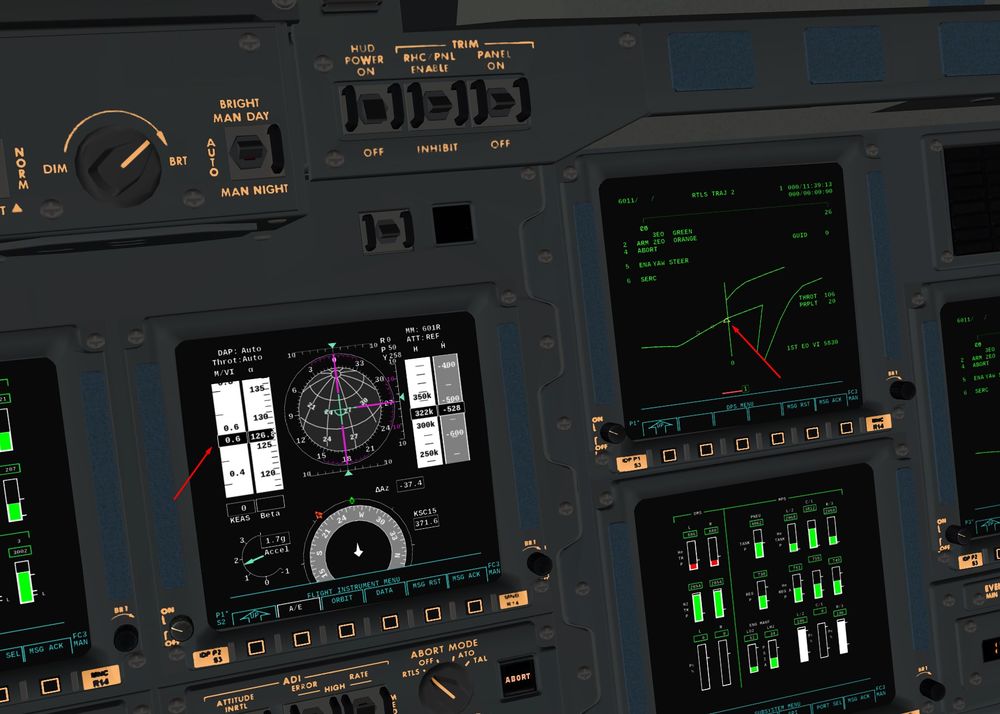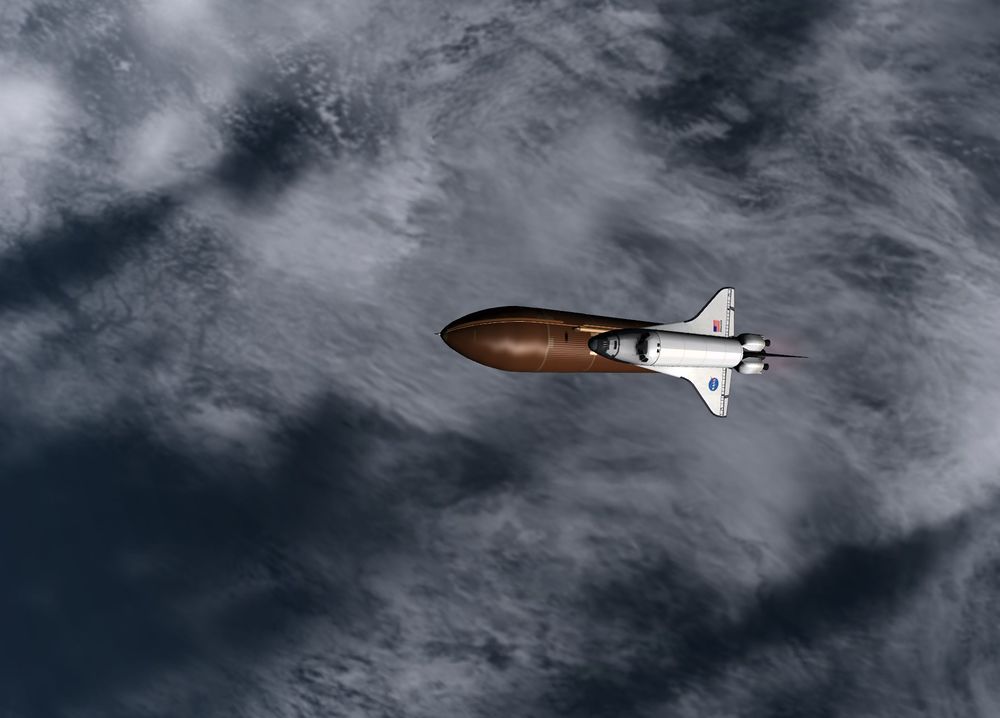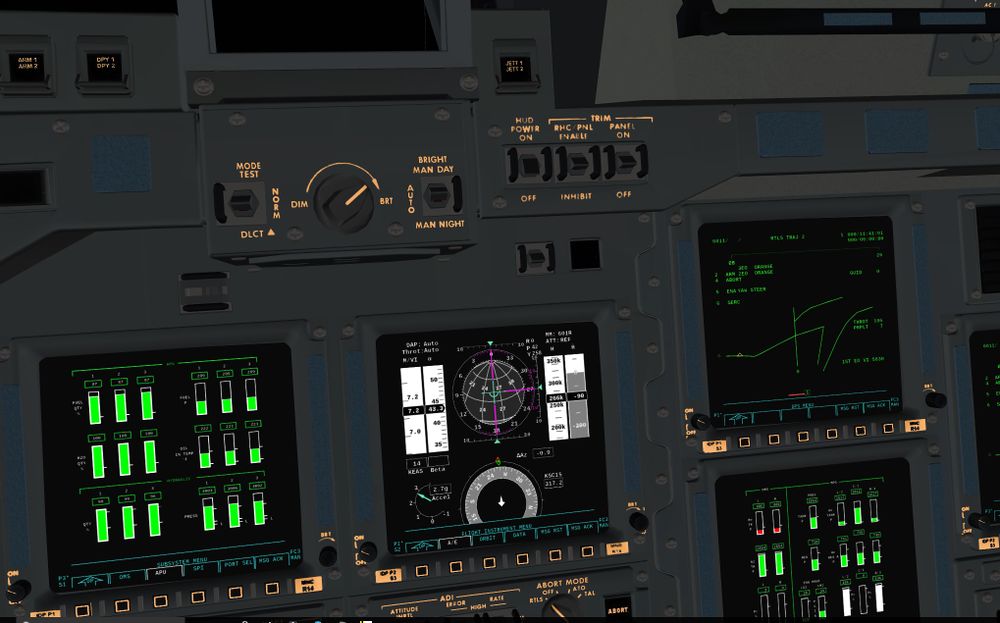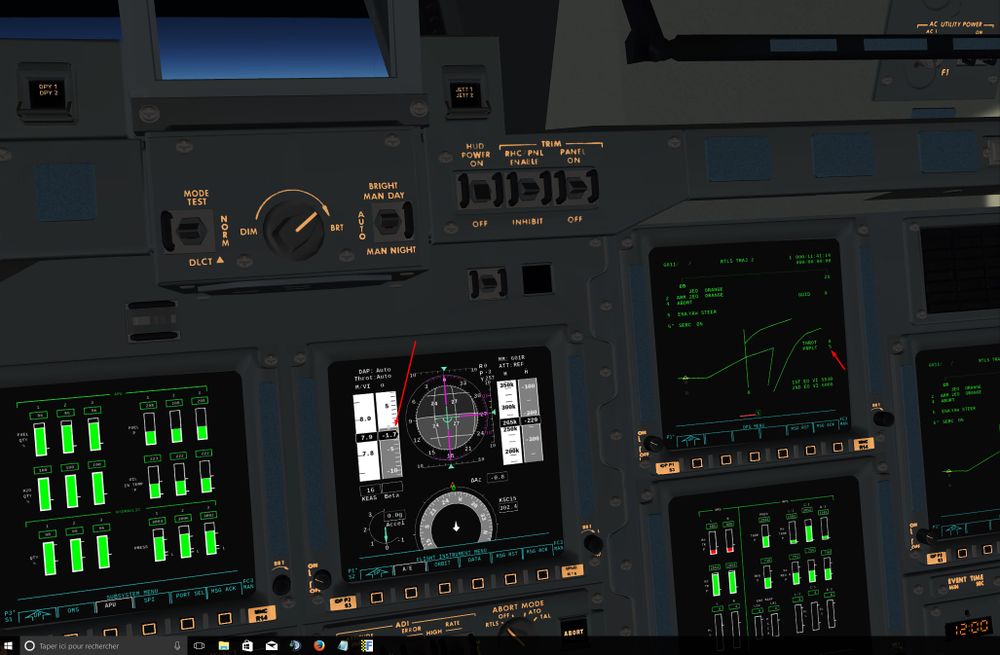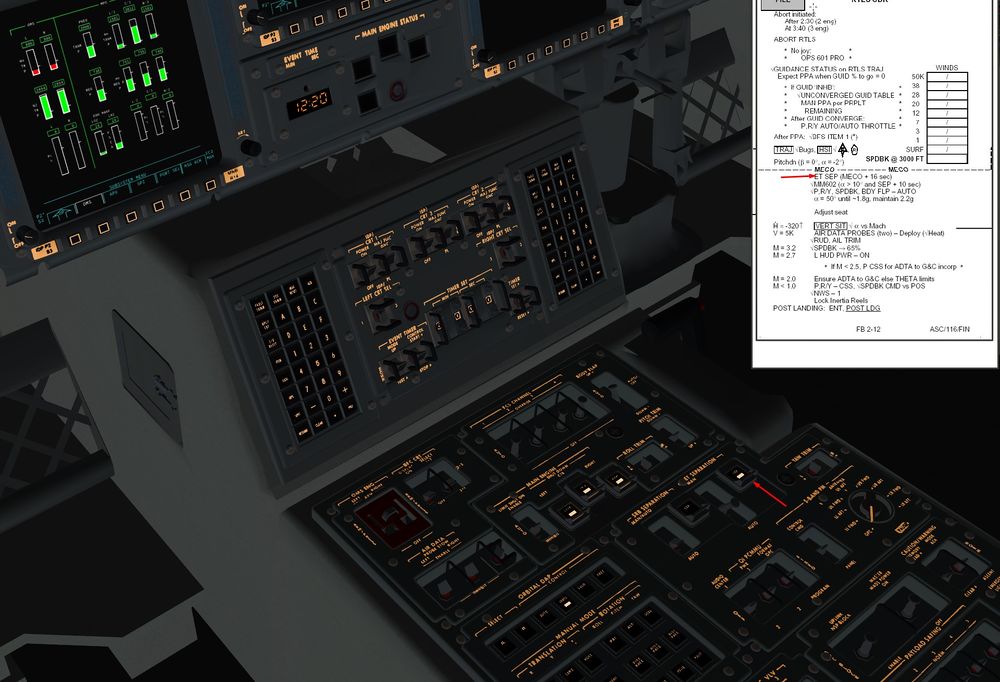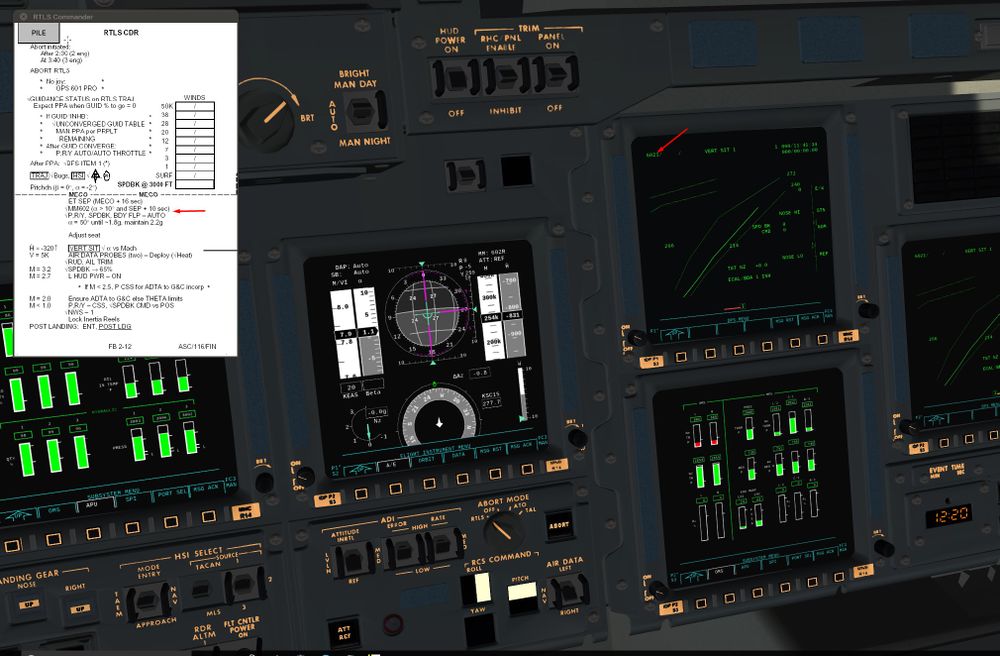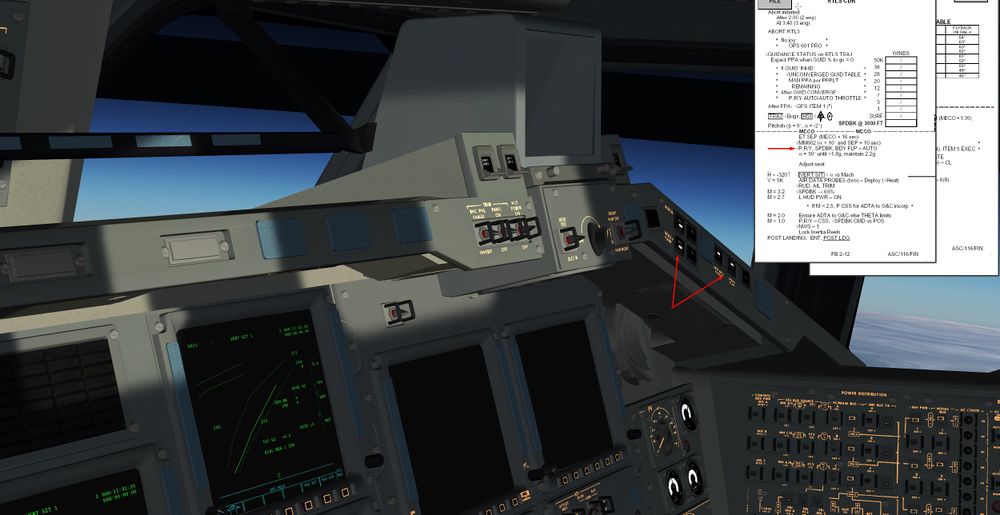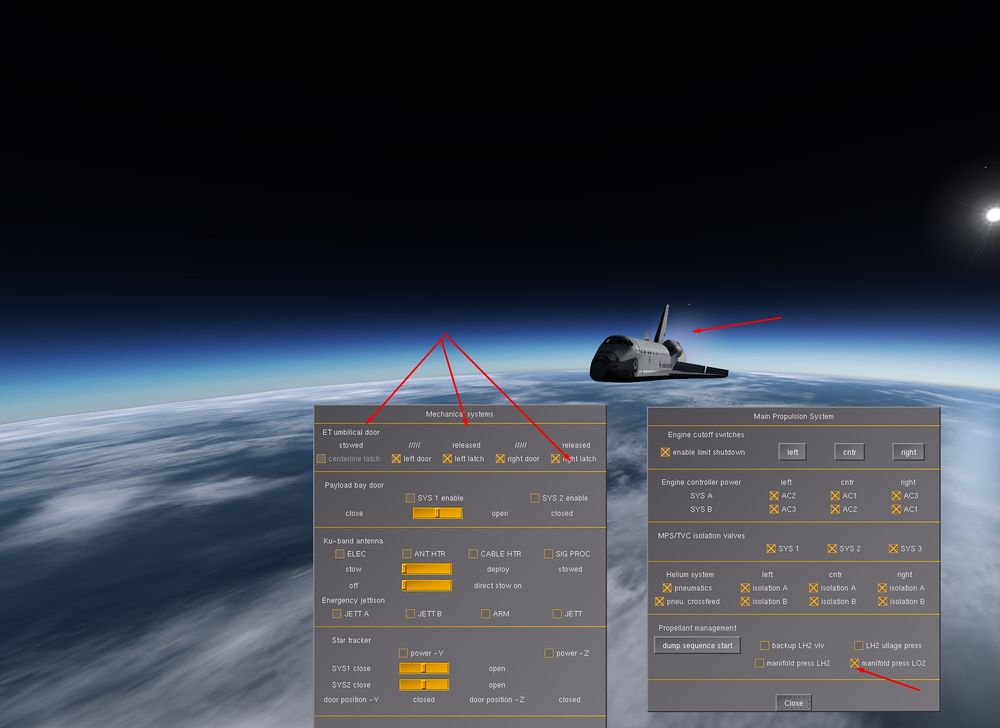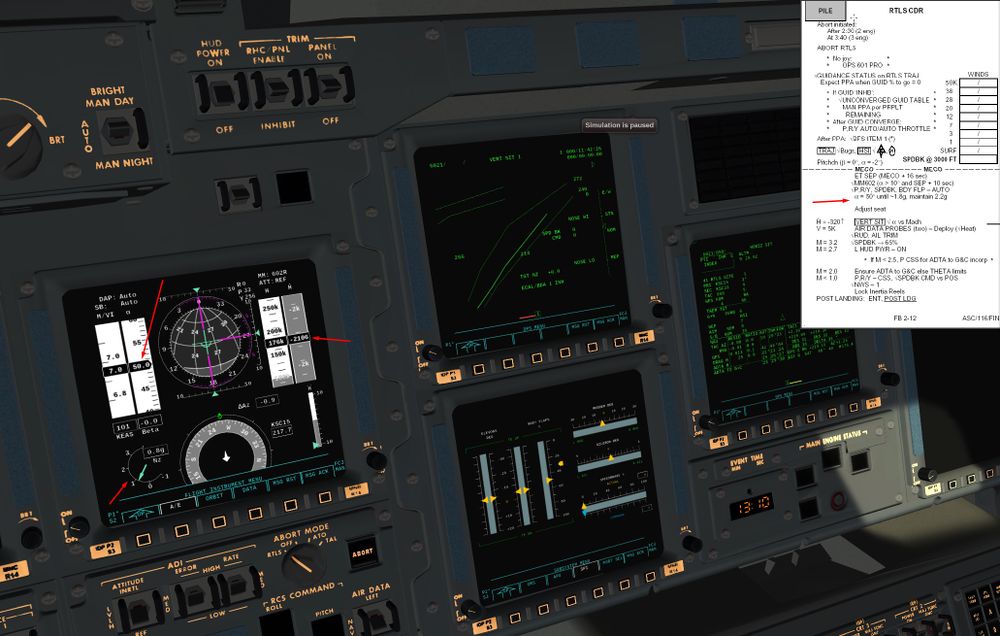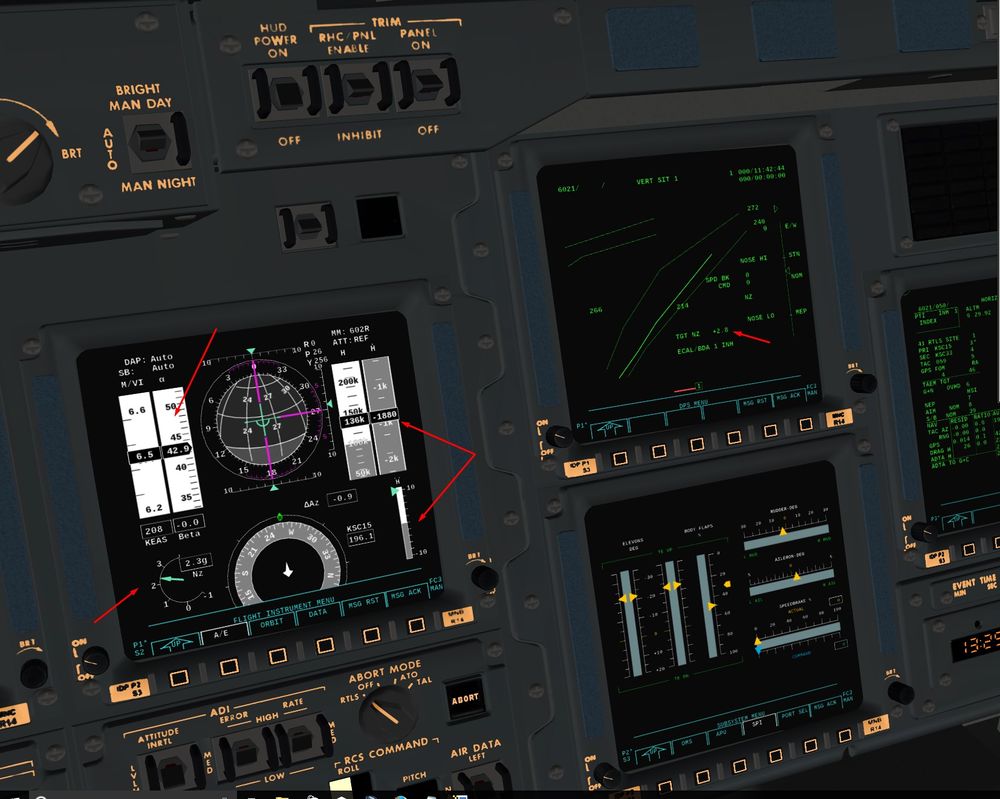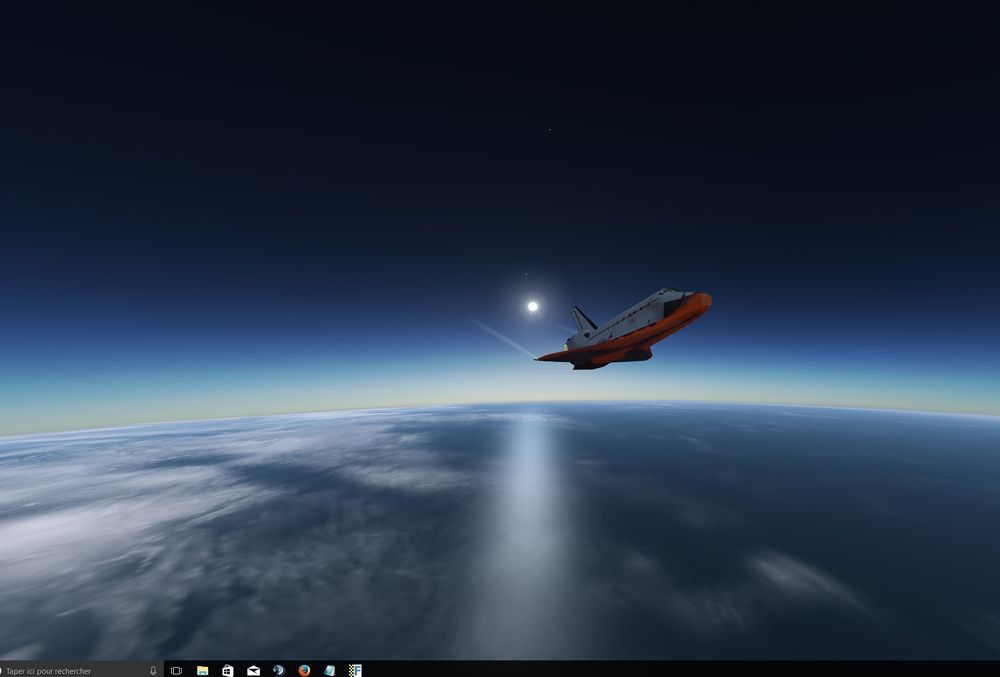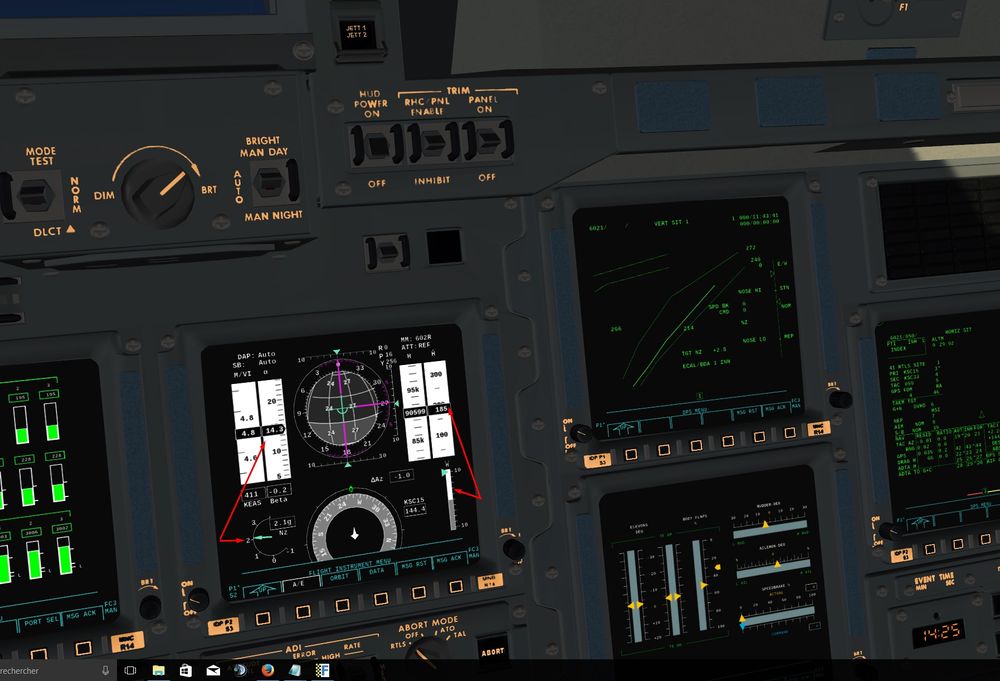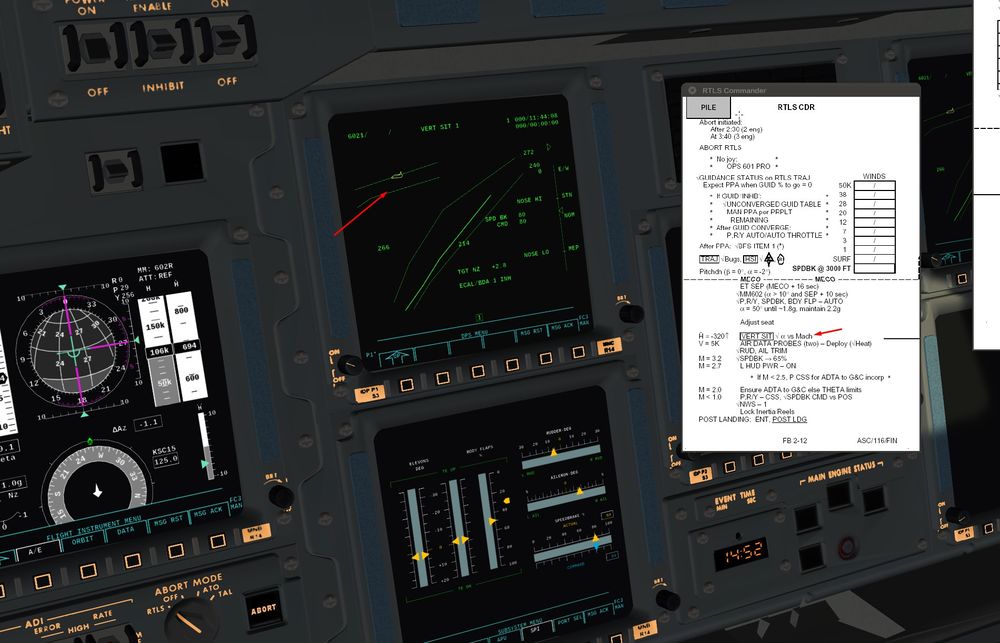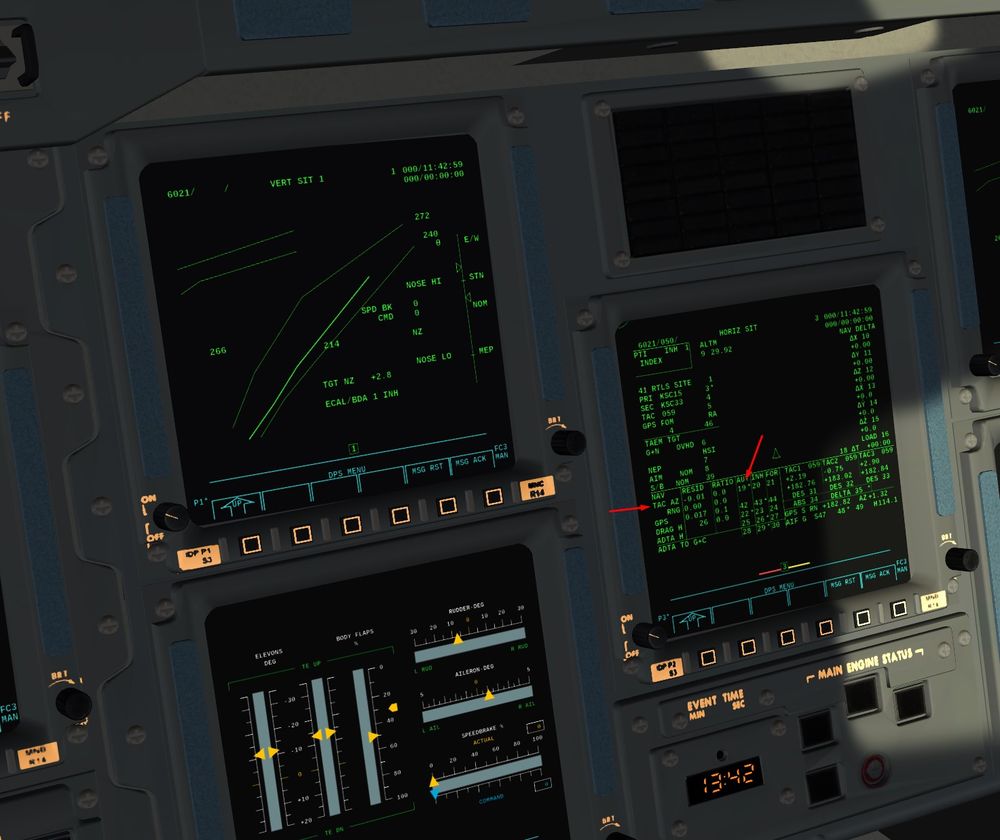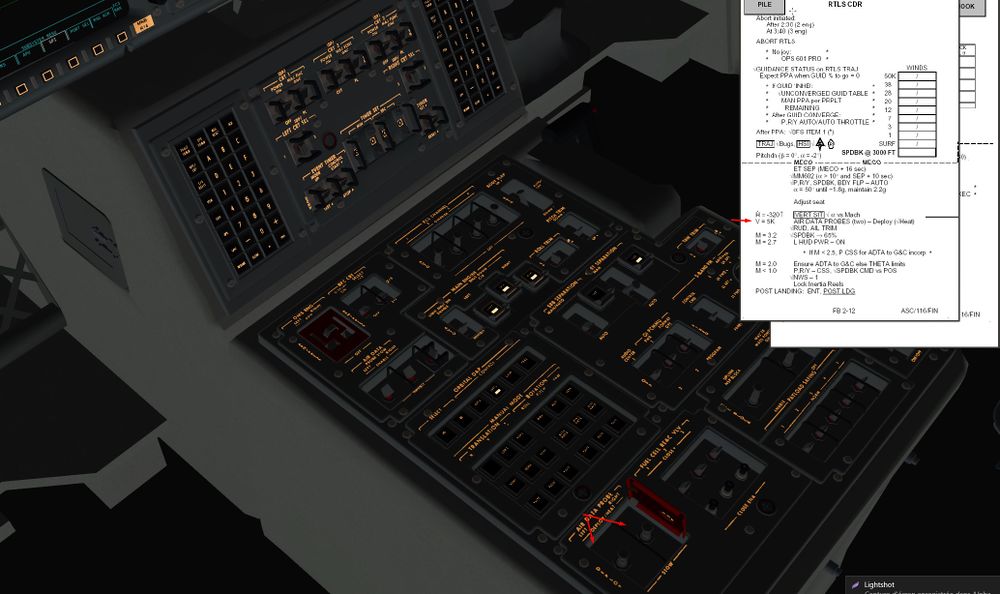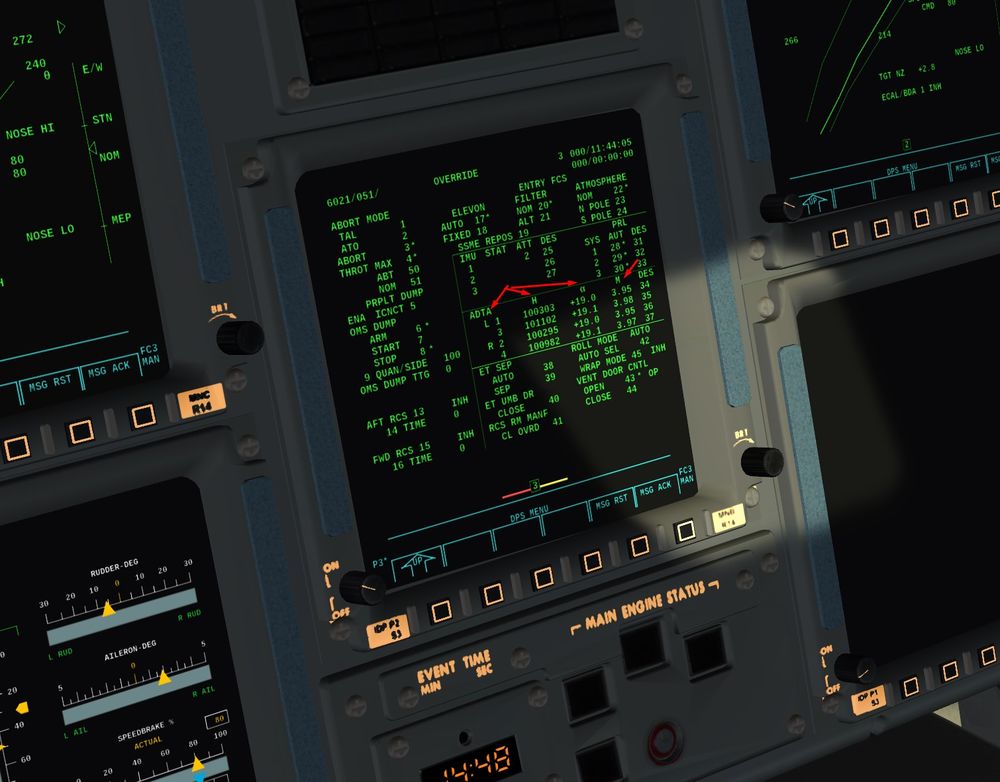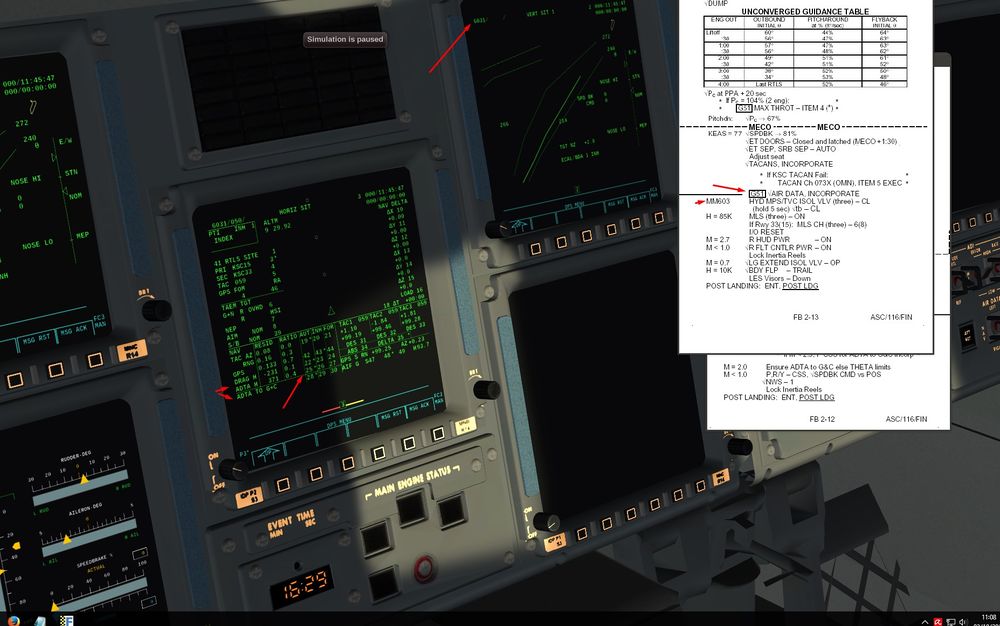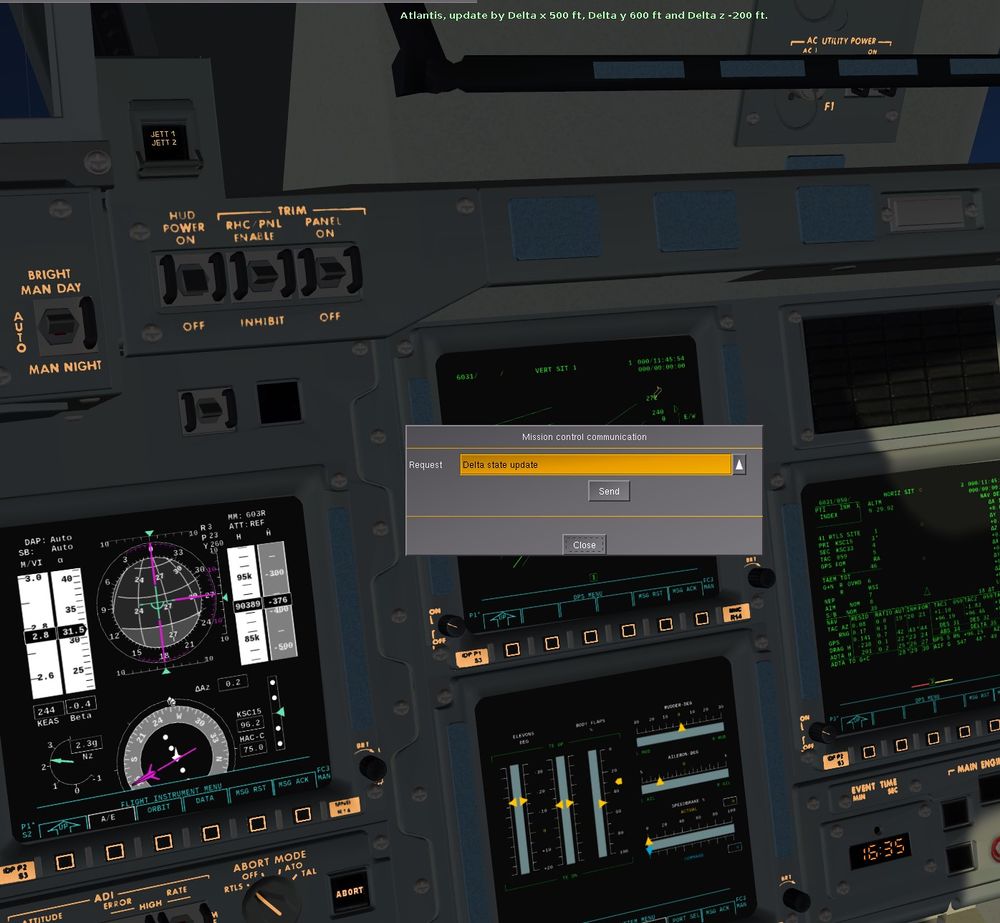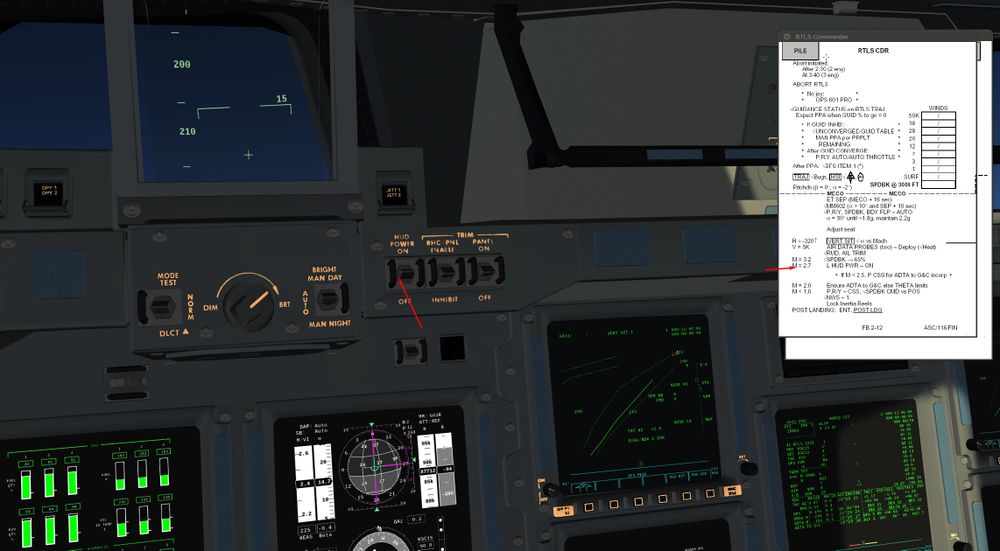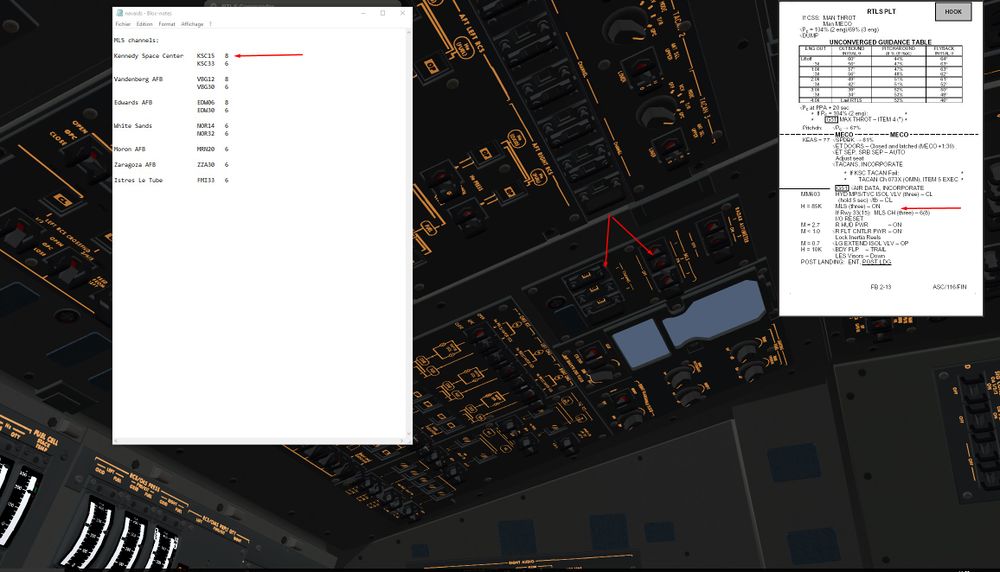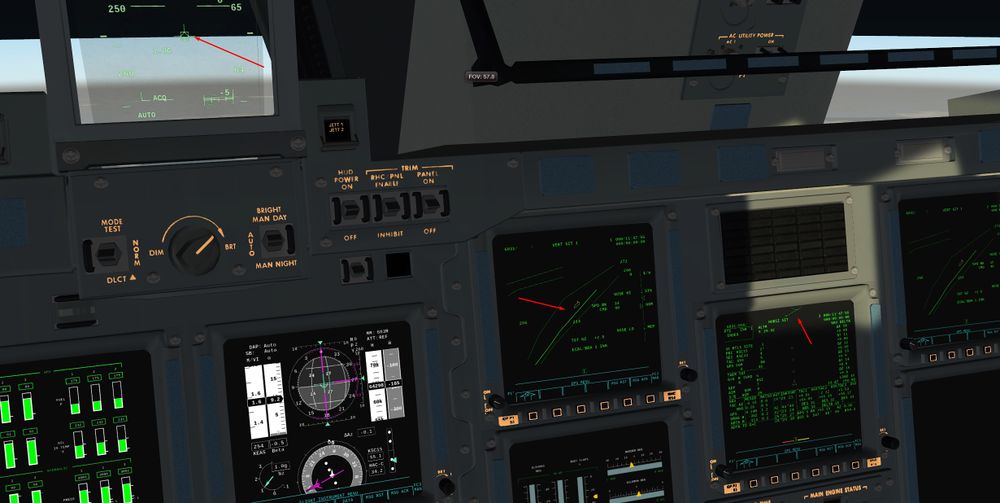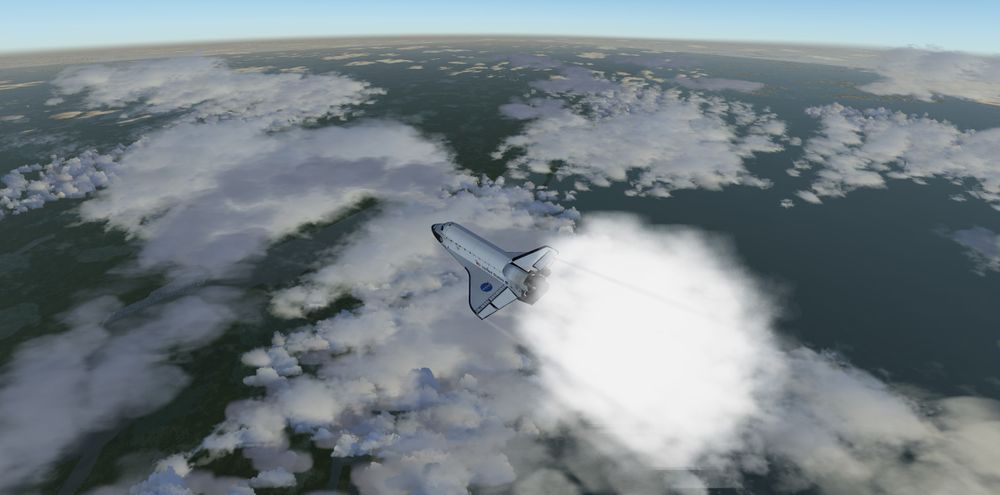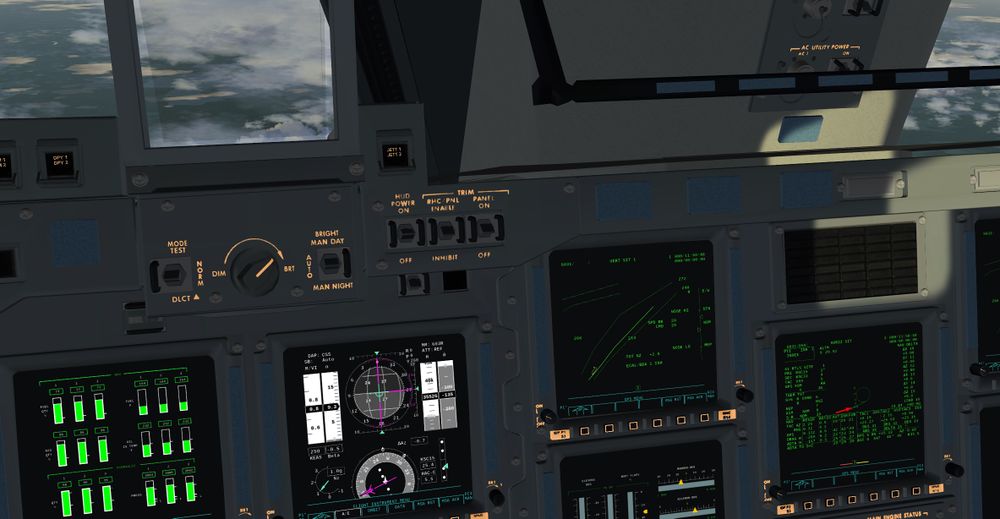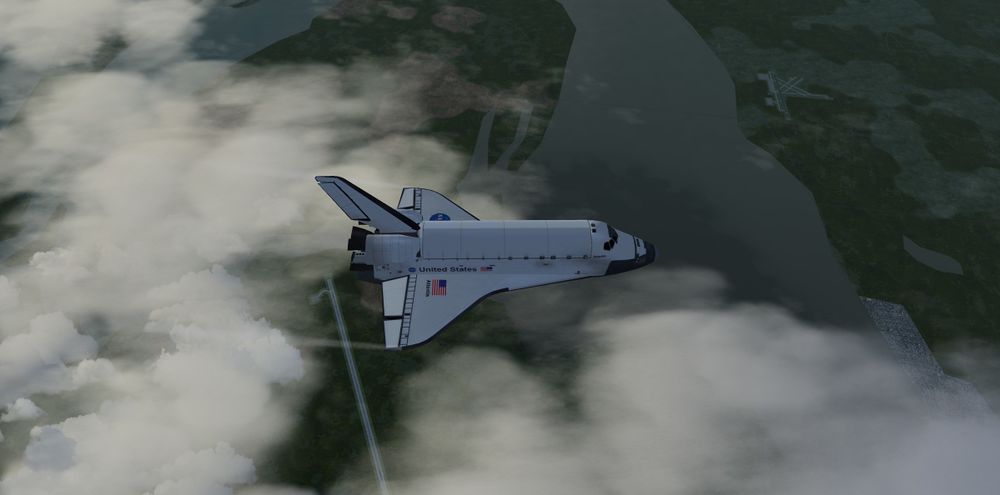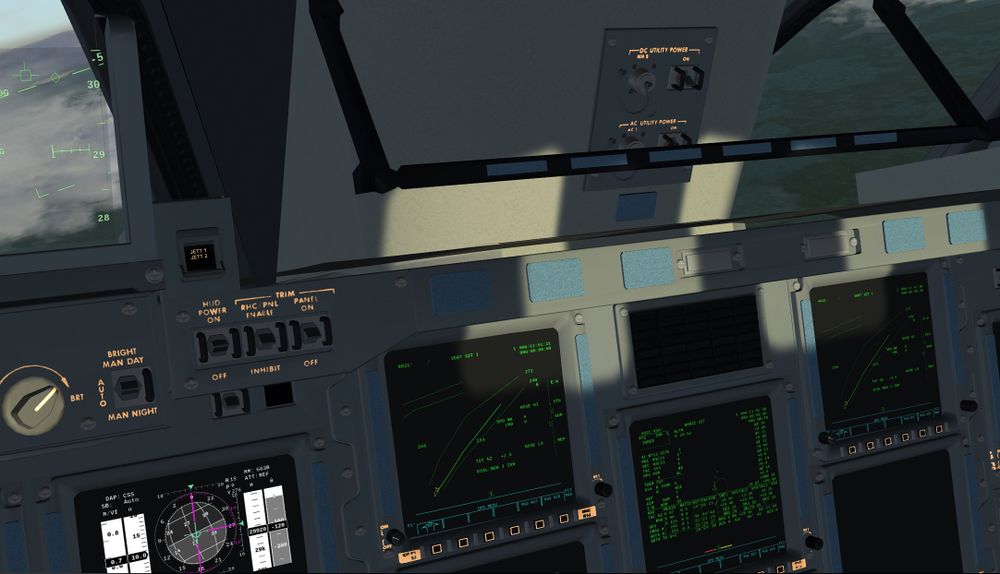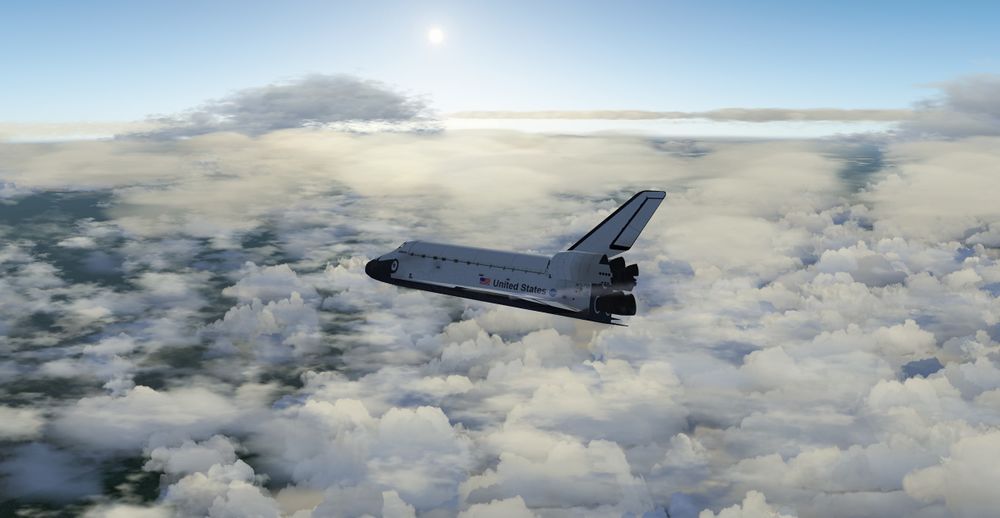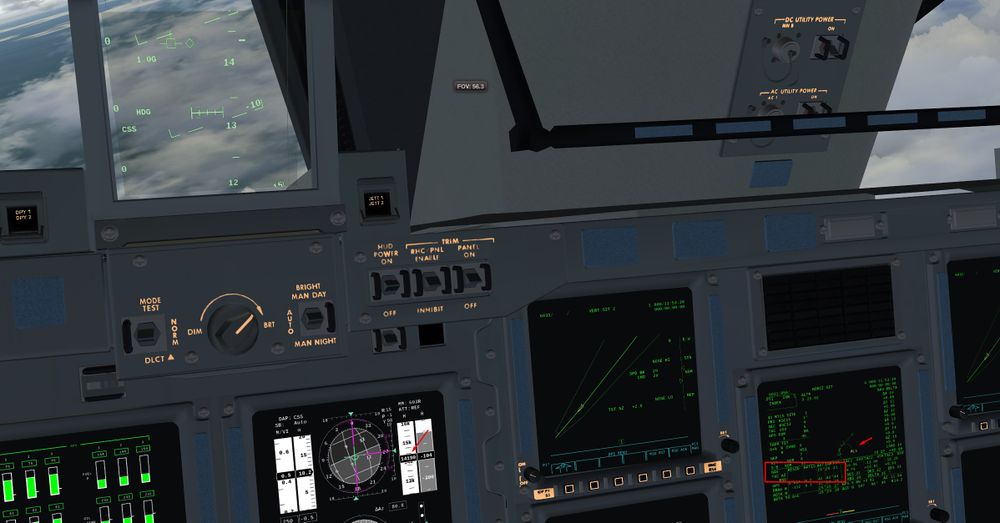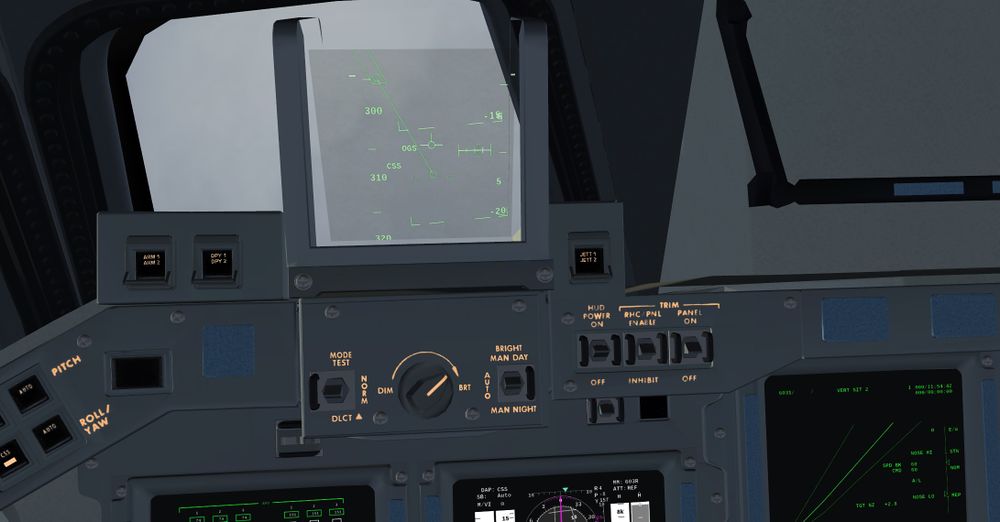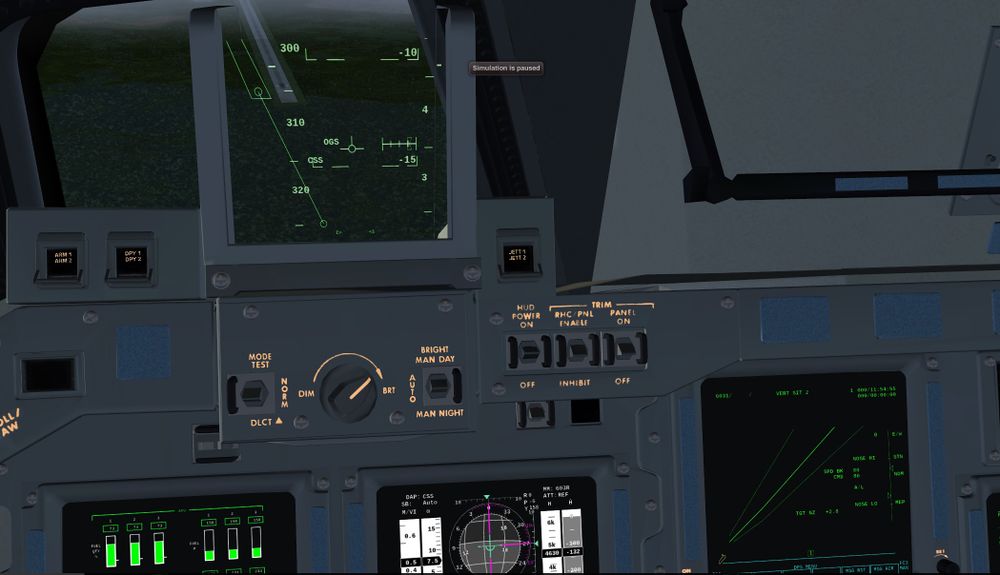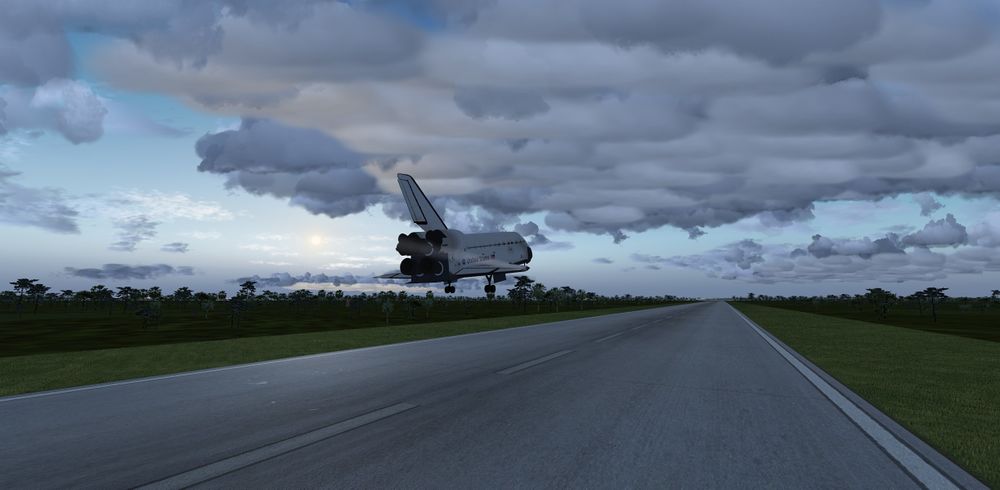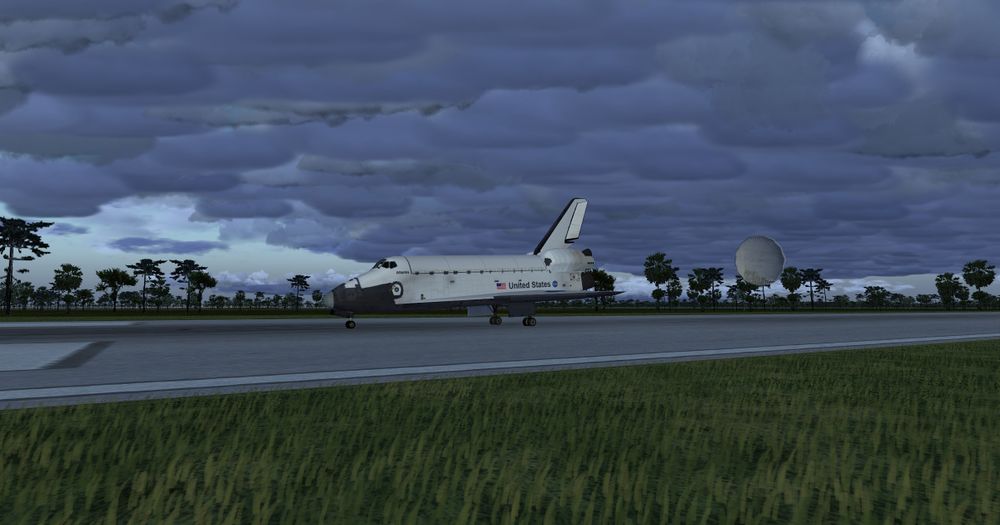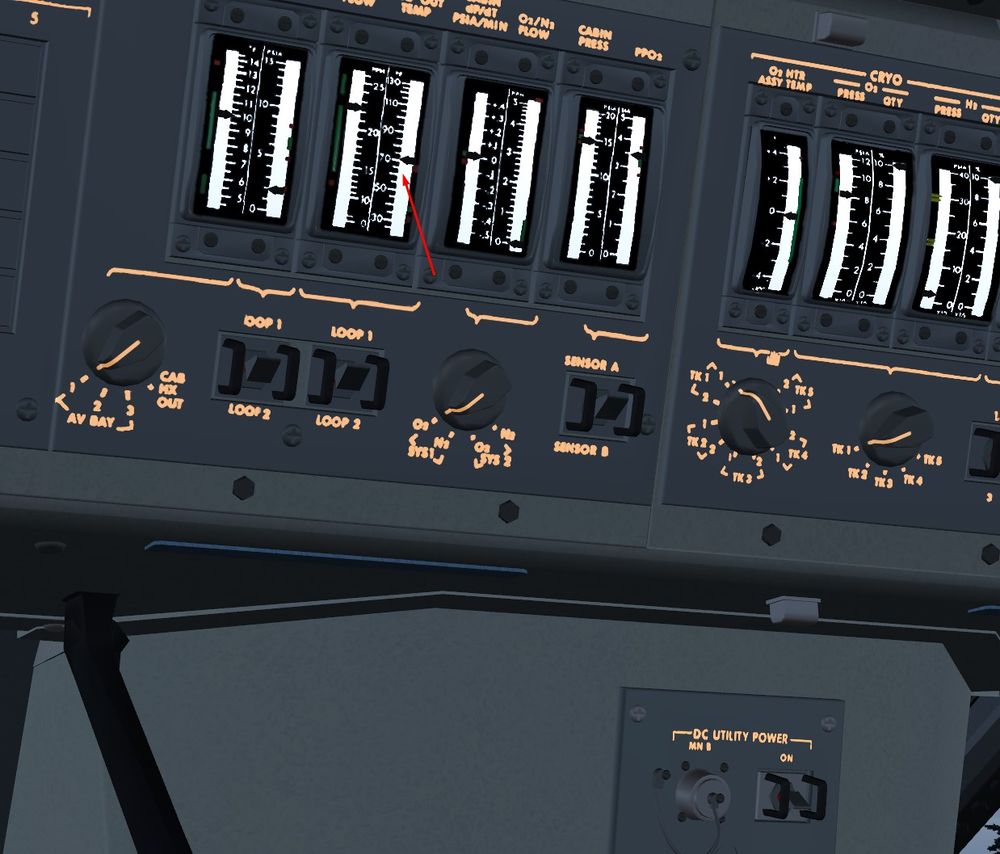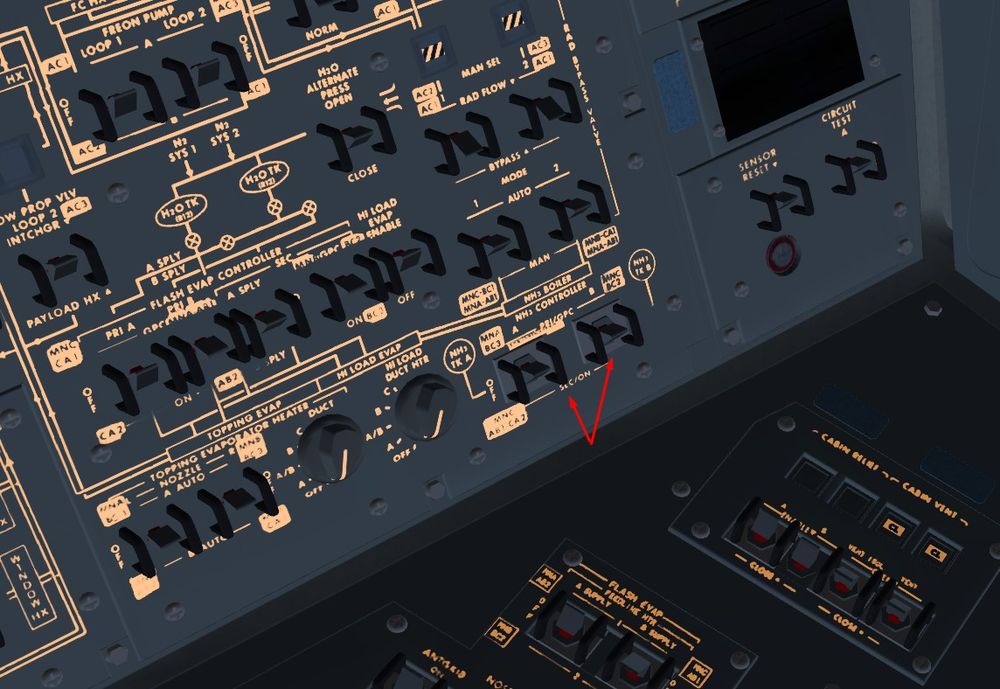Flying the Shuttle - Return To Launch Site RTLS
| Space Shuttle |
|---|
| Main article |
| Checklists |
| Nominal Operations |
| Nominal Operations Advanced Tutorials |
| Intact Aborts |
| Technical |
| The other space shuttle |
(Written for the devel version of October. 2017 https://sourceforge.net/p/fgspaceshuttledev/code/ci/development/tree/)
The Return to Launch Site (RTLS abort) procedure is designed for loss of an engine just after liftoff up to perhaps 3:30 into the flight. It aims to bring the Shuttle back to a landing at the launch site and for that reason is very different from the way the Shuttle normally operates. It also is the most difficult abort procedure, as there are several elements which are time-critical and can go wrong easily. The basic pattern is summarized in the following diagram:
It is one of the most impressive aborts. To fly outbound leg at Mach 7 then invert the speed to come back at Mach 7 towards Florida. It gives vertigo considering how tight the margin is to meet all the guidance and navigation requirements to end up gliding back towards KSC.
The groundtrack of an RTLS abort is an elongated loop, heading out into the launch direction before returning almost the same path:
One very important reading is the RTLS part in the Intact Ascent Aborts Workbook: https://www.nasa.gov/centers/johnson/pdf/383447main_intact_ascent_aborts_workbook_21002.pdf
Everything happens fast in a RTLS, so it's nice to have in the head all the sequence of what will happen. It helps to monitor the AP and take over manually in case of divergence from the nominal track.
Moreover, the work on the RTLS guidance OPS6 , closed loop AP (constantly re evaluating how well it is doing and makes corrections to account for any errors), is astonishing, and very precise if the abort is not declared after the Negative Return Border ( 4 mn into the flight/ Vi around 8 kft/s) in the sim.
Here a sum up of differents boundaries, which are almost the same for every missions, plus or minus a delta Vi depending of the Orbit Inclination Targeted.
One thing with abort is that no abort will be declared until 2:30 mn in the mission. So even if an engine fails during First Stage Ascent ( before SRB Sep), and RTLS is selected, it will not begin the guidance before 2:30mn. That was to let the time to the Orbiter to stabilize after SRB Sep, and to damp any transient states left from SRB guidance.
From there, there are three distinct phases - powered flight, coast and ET separation and final glide.
Latest time to declare a RTLS is at 4:00mn, after the downrange and speed are too high, and TAL would be selected. Usually, for a failure other than an engine, decision to take RTLS or TAL abort was delayed until 3:40 mn to let the time to MCC to evaluate the gravity of the failure, and choose the best abort to deal with it.
Start Flightgear with the commandline options
--aircraft=SpaceShuttle-launch --lat=28.6206 --lon=-80.6133 --heading=90 --timeofday=morning
Heading 90° to have the tail facing the ocean, Shuttle will then perform the famous 180° roll after clearing the Launch tower
From Lift-Off to Pitch Powered Around
Starting on the pad, early morning
Checklists done, Final Countdown and Main Engine Ignition The Shuttle wakes up all Florida
Tower cleared, farewell Atlantis, and safe journey
Failure on the center engine implemented after 2:30 mn
Abort initiated by the Commander,
Many things will happen, Real Checklists in game are available ( Cue Cards), with actions for both Commander and Pilot. Sometimes, a pause in the game might help when it is becoming to dynamic.
First, let's select Max throttle to allow the engines to have access to more power if required
Spec 51 PRO Item 4 EXE
Let's talk about guidance convergence. It will indicate how well is performing the AP, and should decrease close to zero to show that the guidance is nominal and thrustworthy.
Just check the tendency first, if it's decreasing, it's good sign, if not, take manual control
Below unconverged guidance table, you will find some hints on pitch to take during outbound and inbound legs, as well as the % of propellant when to do the turn around towards KSC It's usefull for Manual RTLS, but also to monitor what the AP is doing. Here, failure at 2:30mn, so outbound pitch around 42° and PitchAround when Porpellant ramining is around 50 %
Next step, propellant dump in OMS tanks.
Aim here is to advance Center Of gravity to avoid Loss Of Control(LOC) during entry.
Have a look to the crossfeed valves of both RCS and OMS systems, closed prior to the dump
Automatic reconfiguration will happen during time critical phases, like abort.
OMS tanks will feed RCS thrusters and those will simuteanously fire to dump propellant.
Spec 51 PRO to call the Override Page
Item 6 EXE Item 7 EXE to iniate the dump.
Time to Go of 132 seconds until depletion of OMS Tanks
Have a look again to RCS and OMS panel
CrossFeed Valves are now open, and RCS Isolation Tank Valves are closed. RCS are fed by OMS tanks only to avoid back pressure into RCS tanks, brillant piece of mechanics.
Around 7kft/s of inertial speed, we are approaching 50 pourcent of propellant ramaining.
It's time for the PPA, Powered Pitch Around, where the Shuttle Pitches Around towards KSC
Pitch Powered Around to Pitch Powered Down
Time for PPA, Guidance has fully converged, and remaining propellant around 50 % like planified, perfect.
Back to the Cap
Dump finished, red alert announcing OMS tank pressure Low
We can check deeper on the Sys 2 page, Low pressure in Helium OMS tanks and Low quantites( below 5 %)
A very impressive situation now.
We are inverting our Velocity Vector, Speed relative to Earth is null.
If we loose other engines now, we fall back straight to the sea. One of the most tricky situations during a RTLS
Stationnary position for a brief moment :)
Next crucial step is the PPD, Pitch Powered Down.
Very important manoeuver preceding MECO
Thrust will be gradually decreased and Orbiter will pitch down to an angle of attack of -2° for ET separation. And all that without degrading guidance too much
Approaching the PPD
And PPD followed by MECO, note the angle of attack
Check that the ET is well separated, if not do it manually with Manual ET Sep switches
Then check that GPC transitionned to the next guidance Phase, OPS 602 Glide Return To Launch ( GRTLS)
And also, have a look to confirm that Pitch Roll/Yaw Speedbrake and Body flap are in Auto mode
Glide Return To Launch Site (GRTLS)
Another tricky phase. MECO occured, we are falling back with a high Vertical Speed into atmosphere, which we gonna it hard. Aim here is to not break the orbiter by over G's or EAS exceedance. Normal limits are G=2.5 G and EAS=330 kt, which can be extended to G=4.1 and EAS=470kt for Contigency aborts. These last ones are hard boundaries which will probably break the Orbiter or lead to LOC.
Time critical situation before entry, so ET doors and propellant dump are initiated automatically in the simulation to move forward Center of Gravity
Alpha recovery phase now.
Orbiter will hold a 50° angle of attack attitude until reaching 2 G
Nz hold phase. Depending of the Vertical Speed, Guidance calculates a number of G ( Nz) to maintain to avoid structural damages.
Here it's around 2.8. So when reaching Nz=2.8 G , Alpha will be decreased by a pitch down manoeuver to maintain Nz constant.
Nz hold is a phase where boundary between G and EAS exceedance is very tight.
Manual way to calculate it: When Nz=1G, note the VS ( it was 2000ft/sec)
Nz to hold = Vs at 1G/1000 + 0.65
So, Nz= 2000/1000 + 0.65= 2.65 G ( quite close to the computed one)
Some visuals, no plasma (too low on speed for that),but a bit of glowing tiles
Then comes Alpha transition Phase When Vertical Speed is above -300 ft/sec and increasing, Alpha will vary accordingly to the Mach We can see on the picture some phugoid oscillations, positive vertical accel and speed, up and down :) Also the EAS now decreasing, quite high. We could have take Pitch in CSS to allow a bit more G during Nz Phase ( less pitch down) to avoid speed to increase to much. Very tight border here between pushing and pulling on the stick. We didn't break any hard boundaries, so far, so good.
Gliding back towards KSC now, back on a nominal entry profile.
On Spec50 Horizontal Display, we incorporate TACAN into Kalmann Filters to affinate the State Vector (SV), Ratio is under one and Residual low, SV is looking good.
Item 19 EXE
M=5, probes are deployed
Next Guidance transition, OPS 603 ( Vert Sit 1 and 2)
We check also on Spec 51 that the Probe Data ( ADTA) are correct, cross checked with Primary Flight Display (PFD) value coming for now from IMU
If good, Altitude coming from probes is incorporated in Nav Software by Item 25, and Mach,Altitude, Alpha will feed the Guidance Software and show up on PFD by pressing Item 28
We can ask to MMC how is our SV by a Delta State Update, quite Ok now, ( some small divergence on X,Y,Z axis with reality)
Divergence could be incorporated via Spec 50 and Item 10, 11 and 12.
Item 16 EXE would load the corrections and hence affinate the State Vector.
Approaching Mach2.7, HUD power On
Around 85000 feet, MLS ie. Micro Waves Landing System ( Kind of ILS for precision Landing) channels are selected correctly, number 8 for runway 15 in KSC ( 3 redundant channels)
Approaching the HAC
And it is now time to take manual control by pressing CSS for Pitch and Roll/Yaw channels
After 20 mn of Hyper Sonic Flight, Atlantis is falling below Sound Barrier again
Overhead the Runway
Entering the HAC for a full 270° right
Last turn
On final, below 15000 feet, MLS is automatically activated ( yellow MLS) and TACAN data are not feeding anymore the navigation filter MLS is way more precise than TACAN, updating the SV in a better way. Impressive to see how close to reality those things have been implemented
Breaking the clouds layer
Still a bit of error with SV,but quite ok.
We could have make a GPS Sv update to have a perfect SV ( Item 42 EXE in Spec 50 display) , but it's precise enough for a safe landing...
Then at 2000 feet RA, Pre flare and HUD Declutter to follow the guidance
300 feet RA Gear down and Final Flare
After Nose Wheel on the ground, Drag chute is deployed with Shift+c 60 kts, Drag chute dropped and Wheels stop Welcome back, Atlantis
Small Highlight on Freon Temperature reaching 70 °F
NH3 (Ammonia) boilers can be activated below 120000 feet when FES system is becoming useless (not enough differential pressure to expulse Hot Water in Atmosphere) to cool Freon Loop, no time for Freon Cold Soaked in Radiators during Abort
Well done Astronauts, back alive after a very dangerous Abort, which was considered by the majority of astronauts dangerous by the number of parameters to meet at MECO to have a chance to land back safely in Florida.


